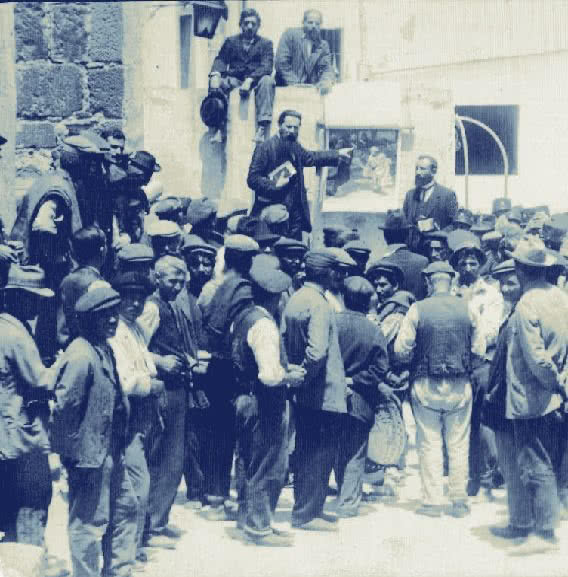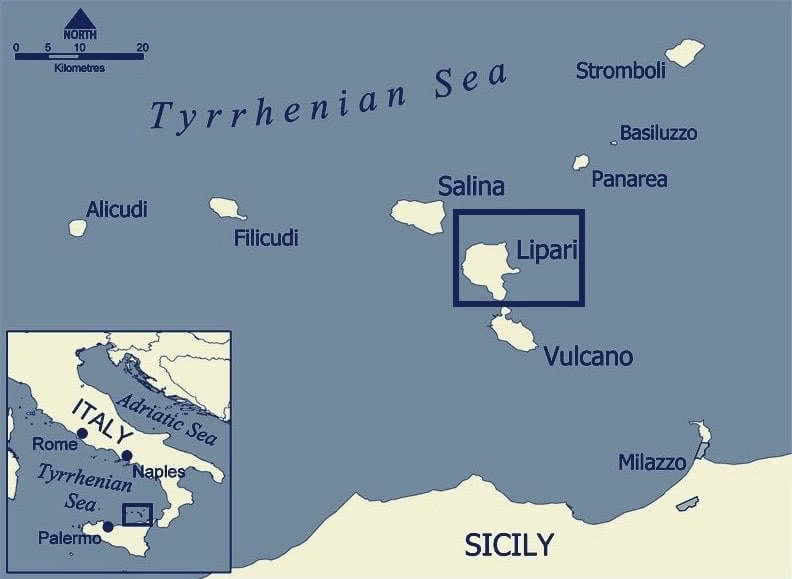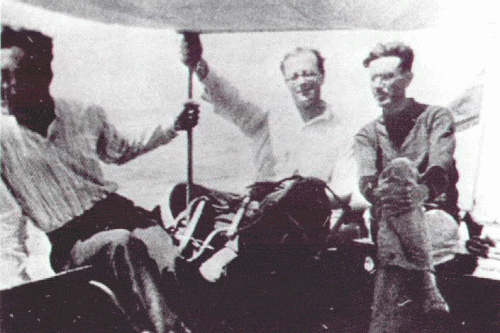LIPARI

Location and Topography
Lipari is the largest of the Aeolian Islands in the Tyrrhenian Sea off the northern coast of Sicily, southern Italy. The Aeolian archipelago consist entirely of volcanic products. Lipari’s last eruption was in 1230 CE and as the largest of all islands in this region, rises from a base of about 2000m below sea level and reaches an elevation of 600m. Today, one can reach Lipari by taking a train from Messina west for about an hour to Milazzo and then a boat northwest for an hour.
Exile History

Lipari’s role as a place of exile was a not a new concept implemented by Italy’s fascist regime. Defined as an “outdated form of punishment”, sixth century Italy continued to practice forms of exile which still appeared to serve the political structure of the time.
In the fifth century CE, Priscus Attalus, a once renowned roman aristocrat, attempted to capture the Roman Emperor of the West – Honorius. While travelling across the western empire in a triumphal procession, Attalus attempted to capture the Empire, albeit unsuccessfully. Attalus was subsequently publicly captured and mutilated by having his thumb and index finger cut off; he was also banished to Lipari where he lived the remainder of his days.
The exile period was revived in 1926 when under Italy’s fascist regime, the Interior of Ministry began to send political delinquents to Lipari. As indicated above, the island’s use as a place of exile was nothing unique, rather, the island was famous in its roman era as a place of exile, however also strangely parallel as a haven for those in therapeutic need. The island’s modern usage as a place of exile ended officially on the 10th of January 1933, with all those still requiring to be exiled relocated to the neighbouring island of Ponza. Despite this “official” closure, the island served as a place of exile for some 450 Ustaše Croatian Nationalists whom threatened the Yugoslavian regime in the wake of King Alexander I’s assassination and French foreign ministers Louis Barthou in Marseille on 9th October 1934. Then, in 1940, the island was converted into an internment camp, somewhat like a “fake” place of confinement. This continued until a US naval expedition landed in Lipari and freed its last remaining prisoners on the 17th of August 1943.
Figures of Note
As a place of exile, Lipari is notable with regards to its brush with notable political and prisoner figures. The most notable interaction comes from the Fascist leader Benito Mussolini who made direct contact with the island and its exile relationship when a strong media attraction became present after the successful escape of three political prisoners: Emilio Lussu, Carlo Rosselli and Francesco Fausto Nitti. The three escaped from the island during the night of July 27-28, attracting worldwide/international press and eventual journalistic engagements with the island.

In the field of arts, Curzio Malaparte, an Italian writer, film-maker, war correspondent and diplomat was sentenced to five years of exile on Lipari. Malaparte was best known for his works: Kaputt and La pelle. While exiled, Malaparte was able to continue to write for the Italian daily newspaper “Corriere della sera”. However, the islands sulphurous volcanic atmosphere flared up Malaparte’s repertory problems which had been affecting him since the First World War. After an intervention by Galeazzo Ciano, a diplomat and Foreign Minister of Mussolini’s fascist regime, Malaparte was moved to Ischia and then Forte dei Marmi in Tuscany to serve the remainder of this sentence.
First-hand Accounts
The primary sources from Lipari’s period of 20th century exile point at the juxtaposition of life on the island from the perspective of the prisoners and the state. Prisoners offer first hand experiences of their experiences on the island. Emilio Lussu, one of the prisoners who escaped, in this book “Enter Mussolini: Observations and Adventures of an Anti-Fascist” provides vivid recounts of his time on the island. He states:
Political prisoners in Italy travel as though they were common criminals. Handcuffed, foodless, and without water to drink, they are conveyed in “cell-carriages” by trains that slowly traverse the country… For transfer by sea they would be crowded in the hold of a steamer with the cattle… The journey from Cagliari to Trapani in Sicily takes eighteen hours. The sea was calm, and after a year in prison, the open air and sunlight gave me a sense of exhilaration, but my fever was still high and I could scarcely stand… I soon discovered that I was being closely watched by police in plain clothes. This was an exceptional measure on the island, and applied only to Torrigiani and myself. Mussolini was afraid that international freemasonry would abduct Torrigiani from Lipari; the discovery that I too was being treated as a person of international importance flattered me not a little.
Francesco Nitti who also escaped the island recounts the economic distress prisoners faced:
We soon found that it was impossible to keep body and soul together on the island with our allowance of ten liras a day. Rents were very high; hovels of two or three rooms cost two or three hundred liras a month. The inhabitants were growing rich on the deportees ... the natives labored under the delusion that we were all wealthy and that they were justified in exploiting us ... In reality, the majority of the deportees were practically without private means and many of them almost starved to death on their pitiful allowance.
Juxtaposed to these accounts are media articles reporting on the escape of the three prisoners. These articles tend depict the exile island in a way that differs from the prisoners. For example, in an effort to hush the international press after the excape in 1929, Mussolini granted a correspondent from Turin’s daily newspaper “La Stampa” access to both Lipari and Ponza
In September 1930, the managing director of La Stampa newspaper, Mino Maccari, saw his eleven-piece exposé of Lipari on newsstands. Despite the prominent byline Dal nostro inviato (From our correspondent) , Maccari had completed the assignment in November of the preceding year:
Towards them, confino is truly a generous, and, I would say, a kind measure without equals. For them, one should indeed define it as ‘holiday’; needless to say, such arrangements scandalised the real political confinati, who number in total some three or four hundred between Ponza and Lipari.
Another journalist allowed to report on the island was Thomas B. Morgan, a correspondent from United Press’s Rome. His article states:
The Lipari Islands, dreaded place of exile for those who run afoul of the Fascist regime, do not look foreboding to the visitor approaching them from Sicily. Set in the blue of the Mediterranean, the ‘Aeolian Islands’ of the Greeks and Romans present a charming picture–their volcanic slopes covered with luxuriant foliage, and their cliffs and peaks presenting a spectacle of scenic beauty. They are not hard to reach, with the proper credentials–although those exiled here have found them hard enough to leave. No restrictions were placed on this correspondent, and I was able to roam at will through the exile colony, talking to anyone and investigating any aspect of the lives of the deportees. Life for the political offenders seems to be what they make it. They are not imprisoned and from 6a.m. until 9p.m. can wander at will and use their time as they please, provided they stay within the territorial limits of the town. Patrols, armed with rifles, are at the wharves and guard the town limits. There is a force of 200 Fascist militia. The deportees are obliged to be in quarters at 9p.m. Patrols make visits to various houses during the night, and the occupants must come to the window and answer ‘present’ when called. There are 250 deportees, all political. Sixty live in barracks provided by the government, which I found modern and comfortable. The remainder, of more means, live either in houses or in rooms which they rent. Fifty have their families with them. Since the colony was established three years ago, thirty have married girls from among the regular civilian population of the island. The deportees are given ten lira a day by the government for living expenses. Ten lira amounts to about 50cents, and it is distributed every morning at roll call. On the whole, my investigation of the island disclosed tolerable healthy conditions with little sickness and almost no discomforts. Dr. Carol Silvestri, former Milan political editor and irreconcilable foe of Fascism, said: ‘I must say in all fairness that life here is not infernal and that this is not the Devil’s island it has been portrayed.
Upon interacting with the people of Lipari today, it was found that testimonies from this period spoke of a strong sympathy and solidarity of the Liparin population towards those who were confined. The clashes with the Fascist militia that occurred during 1929 led to an openly hostile attitude on the part of the local population which led to the decision in the regime to move the Lipari colony to the island of Ponza to avoid further possible evasions.
Contemporary Views
Of all the Aeolian Islands in Sicily, Lipari is the largest, most visited and most accessible. Along with its neighbors, Lipari is inscribed on the World Heritage List under Natural Criterion viii of UNESCO. Its beauty natural beauty extends from its flora its fertile grounds provide to itself and the rest of Italy, to the fauna that includes 74 species endemic or sub-endemic to Italy.
Despite Lipari’s new image as a natural tourist destination, its exile period continues to lay prominent in the fabric of society. Despite the commonality of difficult narratives not being acknowledged by society, Lipari does not shy away from presenting the facts of its history, and in fact, celebrating its heritage. The Aeolian Study Center has published several texts that trace the long period of confinement, first forced and later political, which affected the island and, have plans to publish more in the future.